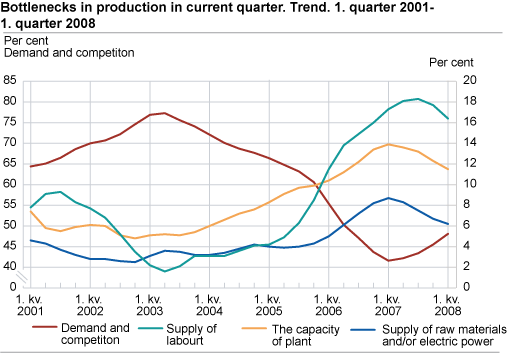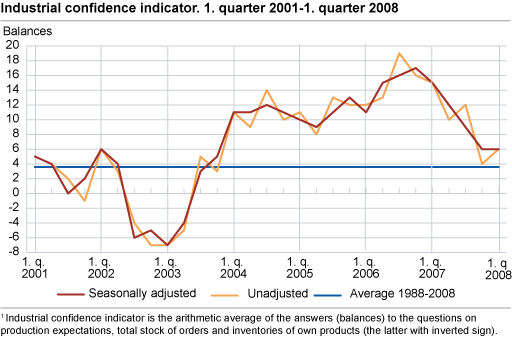Content
Published:
This is an archived release.
Fewer report of resource shortage
Norwegian industrial managers report weaker growth in total output. Bottlenecks in production still pose a major concern, but the situation seems to have calmed down a little.
According to the business tendency survey, the Norwegian manufacturing industry experienced further growth in output and employment in the first quarter, but the increase is somewhat weaker than in the fourth quarter survey. The growth in new orders seems to be levelling out. The fact that a higher number of respondents point at demand and competition as factors that limit production supports this result. However, market prices continued to rise in the first quarter. This may be explained by higher costs. The number of working months covered by the current stock of orders is more or less the same as in the first quarter of 2007. Bottlenecks in the production still pose a major concern, but the situation seems to have calmed down a little (see table 16 ). A higher degree of automation due to a rise in investments (see Quarterly Investment Statistics ) contributes to this development. The average capacity utilisation in the Norwegian manufacturing industry is estimated to about 84 per cent. International comparisons of average capacity utilisation are available from EUROSTAT .
The general short-term outlook (Q1 2008) is considered to be positive. Expectations of further growth in total output and higher market prices support this result. So does the industrial confidence indicator1 which is estimated to 6 (seasonally adjusted net figure) in the first quarter. International comparisons of the industrial confidence indicator are available from EUROSTAT (EU) and the Swedish National Institute of Economic Research (Sweden).
Decline in new orders
Sectors producing intermediate goods (pulp, paper and paper products, chemical industry, basic metals, etc) report of a moderate increase in output and employment. The total stock of orders is lower than in the fourth quarter, which seems to be the result of a decline in new orders from export markets. However, there are also indications of a negative development in the domestic market. A rise in the number of industrial managers who point at weak demand as a limiting factor for production supports these results. Furthermore, there has been a continued decrease in export prices. A combination of a marked decline in economic growth among our trading partners and a weaker US dollar is a likely explanation for this development. The average capacity utilisation is estimated to about 84 per cent in the first quarter of 2008. The number of working months covered by the current stock of orders is the same as in the corresponding quarter of 2007.
The general short-term outlook is considered to be positive, but fewer share this opinion and few consider increases in gross capital investments. Prospects of reduced profitability may be the reason for this development.
Fewer report of shortage of qualified labour
Sectors producing capital goods (metal products, machinery and equipment, offshore-related activity, etc) experienced yet another quarter with strong growth in output and employment. The growth in new orders is still considerable, and the total stock of orders is at a record high level (see Statistics on new orders ). A further rise in market prices reflects this development. The number of managers who point at shortage of qualified labour as a factor that limits production is somewhat lower than in the corresponding quarter of 2007. This may be explained by increasing automation combined with outsourcing abroad. Average capacity utilisation is estimated to about 89 per cent in the fourth quarter. The number of working months covered by the current stock of orders is more or less the same as one year ago.
A majority of the industrial managers consider the general short-term outlook to be better. Expectations of further growth in new orders and a strengthening of market prices support this view.
Strong growth in home market prices
Sectors producing consumer goods (food industry, publishing, pharmaceutical industry, etc) experienced continued growth in total output, but the growth rate was somewhat lower than in the fourth quarter. Lower increase in demand from the home markets explains this result. Market prices continued to rise in both the domestic and export markets. A strong growth in prices of food products contributed to this development. Average capacity utilisation is estimated to about 80 per cent in the first quarter.
A majority of the respondents consider the general short-term outlook to be better. Expectations of high demand in the domestic market and strong growth in market prices support this result.
1The industrial confidence indicator and links to international comparisons are described in the press release Q3 2003 (see Previous articles )
| Industry | Prospects | Background | |||||||||||||||||||||||||||||||||||||
|---|---|---|---|---|---|---|---|---|---|---|---|---|---|---|---|---|---|---|---|---|---|---|---|---|---|---|---|---|---|---|---|---|---|---|---|---|---|---|---|
| Food products, beverages and tobacco | ++ | Higher levels of production, capacity utilisation and employment. Increase in demand from the domestic and export market. Improved market prices. The general outlook for Q2 is judged as better. Further growth in output, employment and demand is expected. Export market prices are expected to level out. | |||||||||||||||||||||||||||||||||||||
| Wood and products of wood | -(+) | More or less unchanged levels of production and employment. Reduced level of capacity utilisation. Decrease in new orders from the domestic and export market. There is a sharp increase in the number of managers reporting that weak demand is a limiting factor for production. Domestic market prices are more or less unchanged, while export prices have fallen. The general outlook for the forthcoming quarter is considered to be better, and increases in output and new orders are expected. Market prices are expected to fall. | |||||||||||||||||||||||||||||||||||||
| Pulp, paper and paper products | - | Reduced levels of production, capacity utilisation and employment. Reduced level of new orders from the domestic and export market. Export market prices are lower. A growing number of managers report that weak demand from the export market limits production. The general outlook for Q2 is judged as better. Increase in output and improved market prices are expected in the forthcoming quarter. | |||||||||||||||||||||||||||||||||||||
| Basic chemicals | ++ | Growth in output, capacity utilisation and employment. New orders from the domestic and export market have increased. Positive development in market prices. Lack of raw materials and/or electric power limits production. Many managers judge the general outlook for the forthcoming quarter as better, and further increases in production, new orders and market prices are expected. | |||||||||||||||||||||||||||||||||||||
| Basic metals, non-ferrous | - | Lower levels of production and capacity utilisation. More or less unchanged level of employment. New orders and market prices from the export market are reduced. Many managers report that weak demand from the export market limits production. The general outlook for Q2 is considered as worse, and there are expectations of lower level of new orders and reduced market prices in the forthcoming quarter. Output is expected to rise. | |||||||||||||||||||||||||||||||||||||
| Engineering, total | ++ | Overall, the engineering industries have a positive development with increases in production, capacity utilisation and employment. The total stock of orders has increased, and the market prices are improved. Many managers still consider lack of qualified labour and shortage of capacity as limiting factors for production. The general outlook for Q2 is judged as better, and further increases in output, employment, new orders and market prices are expected. | |||||||||||||||||||||||||||||||||||||
| Metal products | ++ | Growth in production levels, capacity utilisation and employment. Rise in new orders from the domestic market, while the level of new orders from the export market is more or less unchanged. Improved market prices. The general outlook for Q2 is positive, and further increases in output, employment and market prices are expected. The level of new orders is expected to be more or less unchanged. | |||||||||||||||||||||||||||||||||||||
| Machinery and equipment | ++ | Continued positive development with increases in production, capacity utilisation, employment and new orders. Market prices have improved further, both in the domestic market and export market. Lack of qualified labour and shortage of capacity are limiting factors of production. The general outlook for Q2 is considered better, and growth in output, employment, new orders and market prices are expected. | |||||||||||||||||||||||||||||||||||||
| Electrical and optical equipment | ++ | Continued growth in the levels of production, capacity utilisation and employment. Rise in new orders and improved market prices. Lack of qualified labour and shortage of capacity limits production. Many managers consider the general outlook for Q2 as better, and further increases in output, employment and new orders are expected. | |||||||||||||||||||||||||||||||||||||
| Offshore-related activity incl. transport industry | + | Increases in output, capacity utilisation and employment. New orders and prices in the domestic market have risen, while the total stock of orders is more or less unchanged. Export prices have fallen. Fewer managers report that shortage of capacity limits production, but lack of qualified labour is still a considerable bottleneck. The general outlook for Q2 is judged as better, and there are expectations of higher levels of production and new orders. | |||||||||||||||||||||||||||||||||||||
| The column for Prospects shows an overall evaluation of the present situation and expected short-term developments using the symbols + and -. The following codes and constellations are used: |
++
+ ² - -- -(+) +/- |
Meget god
God På det jevne Svak Meget svak Svak, men med enkelte positive tegn Situasjon der + og - faktorer jevner ut hverandre |
|||||||||||||||||||||||||||||||||||||
Additional information
The statistics provide current data on the business cycle for manufacturing, mining and quarrying by collecting business leaders’ assessments of the economic situation and the short term outlook.
Contact
-
Edvard Andreassen
E-mail: edvard.andreassen@ssb.no
tel.: (+47) 40 90 23 32
-
Ståle Mæland
E-mail: stale.maeland@ssb.no
tel.: (+47) 95 05 98 88


